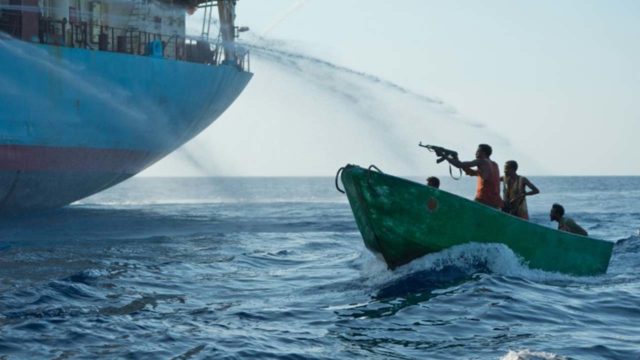Last week American commandos rescued Richard Philips, the Captain of an American cargo ship, the Maersk Alabama, who had been taken hostage by Somali pirates operating off shore in the Indian Ocean. Three precise shots by three snipers killed three of the pirates holding Cptain Philips, in a lifeboat. The crew had successfully taken back their cargo ship from the pirates, but in turn, the pirates took Captain Philips as hostage. The Americans took the fourth pirate away to the United States to stand trial. And in the wake of the attack on the American ship, the United States has signalled the intention to get tough with the perpetrators of piracy in the Indian Ocean.
Even as Captain Philips was rescued, elsewhere there were 260 crew held on 14 hijacked ships. In 2008 alone, a total of over 100 ships were attacked, among them were Norwegian, Greek, Saudi, Danish, German and Turkish ships. It is also important to mention the fact that more 20,000 ships pass through this part of the Indian Ocean annually. It is therefore clear that piracy has become what someone described as “a niche business” that is proving very difficult to eliminate. It does not seem clear that a solution is in sight, even with the best efforts at the moment; the European Union along with the USA, Iran, Russia, India, China, Japan and other nations has ships patrolling the ocean off the Somali coast.
The 21 century ressurgence of piracy around the coast of Somalia is related to the fact that Somalia is a failed state with a failed economy which has 1,900 miles of coast line. It is said that piracy passes as a national industry which offers employment as well as a commensurate income. Furthermore, shipping companies are more inclined to pay ransome when their ships come under attack. In 2008 alone, it is estimated that $80million was paid out; this is preferred to the interruption of traffic. It is similarly stated that given the vast expanse of open water to patrol, the task of confronting pirates is daunting; they have begun to attack shipping further ashore. Piracy is said to be a business model without regard to politics and religion; it is an expression of the desperacy of people who have organised to survive!
In the second half of 2008, no less than four meetings of the UN Security Council were prompted by persistent and high-profile acts of piracy off the coast of Somalia. As pushed by the major powers, the goal was to begin to rein in the growing threat to commercial activities in one of the world’s most important shipping lanes. In its December meeting, the council authorized governments that are already carrying out naval operations in Somali waters to possibly extend their anti-piracy efforts to land and air. But UN Secretary-General Ban Ki-moon stressed that Somalia’s piracy problem cannot be divorced from the need to forge a comprehensive peace agreement for the country. Dumisani Kumalo, South Africa’s UN representative, had also told an October council meeting, that piracy in Somalia, is “part of the larger problem of the lack of peace and stability”.
Actual progress against piracy has to be firmly linked to stability, which a comprehensive peace process alone can guarantee; and that will then open up economic opportunities ashore in Somalia, which has been bloodied by 20 years of chaos, with no credible central government or even territory held by a civil authority. Kerstin Petretto, a researcher at the German Institute for International and Security Affairs, noted that weak coastal states located near shipping “choke points”, where traffic is slow, are the most likely havens for piracy. The description fits the waters off Somalia, and a few other parts of the world, such as West Africa’s Gulf of Guinea, which saw 40 pirate attacks between January and November 2008.
So while piracy is not limited to Somali waters, off Somalia, piracy is more common. Since the International Maritime Organisation (IMO) began keeping records in 1984, there have been more than 440 reported acts of piracy off the Somali coast. The IMO Secretary General, Efthimios Mitropoulos, told the UN Security Council in November 2008, that “Of these, 120 took place in 2008 alone”. More than 40 ships and 600 seafarers have been seized, while pirates have collected an estimated $120million in ransom. Somali pirates are also sailing increasingly farther into the Indian Ocean from bases in Puntland, in northern Somalia. One vessel, the Sirius Star, a supertanker carrying two million barrels of oil, was hijacked 450 nautical miles (833 kilometers) south east of Kenya’s port of Mombasa; farther south than any previous attack. “This incident is significant on two counts”, says International Maritime Bureau (IMB) Director, Pottengal Mukundan. “Firstly, this is the largest vessel to have been hijacked. Secondly, the distance from the shore would suggest a highly organized operation-this is not mere opportunism”!
In 2008, insurance premiums rose by 12-15 percent as a result of rising pirate attacks and a hike from $500 to $20,000 of the special risk insurance for each ship passing through the Gulf of Aden, which skirts Somali waters. Ships can go around South Africa’s Cape of Good Hope to Europe instead; but the Gulf of Aden route is faster and cheaper. It also serves about 20,000 vessels annually, carrying over 12 percent of all the oil transported by sea. An October 2008 report by the Uk-based think tank, Chatham House, said that “Somalia is a perfect environment for piracy to thrive”, because it has very little functioning government, long, isolated beaches and a population that is desperate and accustomed to war. Within Puntland, where most of the pirate attacks originate, the hijackings are seen as an important source of income, providing jobs and opportunities for hundreds.
One of the least reported aspects of the problem, is that many pirates started out as fishermen. As Ms. Petretto pointed out, Somalia’s fishing waters used to be a source of community income; but over time, they attracted many European and Asian fishing vessels, whose expolitation depleted fish stocks and in turn helped to prompt the Somali’s “sense of justification in targeting foreign ships”. Unfortunately, there has not been successful anti-piracy efforts in the region, until the June 2008 UN Security Council authorization for naval powers to conduct patrols off Somalia. In response naval ships from more than a dozen countries, including NATO and European Union members as well as Russia and India, have taken turns to patrol the waters. Consequently, successful hijackings fell from 53 percent of total attacks to 31 percent between August and October 2008. But the area is too vast- an estimated 6.5mn square kilometer- to police effectively.
Unfortunately, African countries do not have the resources to contribute to these efforts. Chris Trelawny, the IMO’s chief of maritime security, said that African countries do not “have the money for fuel, never mind the hardware, to run adequate surveillance at sea or port security”. Len le Roux of the South African Institute of Security Studies also said to be effective against piracy, African costal countries would need “effective early warning and intelligence services, credible deterrent and reaction forces…high mobility…and the ability to sustain operations for long periods”. Those are precisely the capabilities “sorely lacking in Africa”. Worse still, le Roux said regional solutions are lacking. He notes that the African Union’s arrangements to establish standby peacekeeping forces do not address maritime threats. Those plans, he says leave “the impression of an Africa without a coastline or maritime zone, let alone broader maritime interests such as trade and resources”.
The Chatham House report significantly noted that although piracy has been a problem since the collapse of the Siad Barre regime in 1991, it almost vanished during the six-month rule of the Islamic Courts Union in 2006. “This indicates that a functioning government in Somalia is capable of controlling piracy”, the report argues. At a December 2008 UN-sponsored meeting in Nairobi to tackle piracy, the UN Office on Drugs and Crime (UNODC), presented a number of concrete proposals, backed by 40 countries who agreed to trace, track and freeze assets of those who back Somali pirates. “Regional cooperation is essential”, UNODC Executive Director, Antonio Maria Costa emphasised in mid-December. The proposed measures include cooperation to place law enforcement officials on board warships operating in Somali waters and to bring captured pirates to justice in local courts; a system that is said to have succeeded in the Carribean.
The United States Navy SEALS took the split-second decision last week to gun down three pirates who held Captain Philips, who had allowed himself to be taken hostage to protect his crew. The action has been hailed in American and other western media circles as an event with a “heroic ending” and that “the good guys won this time”. But they also know that a concerted international action will be needed to rein-in the menace of piracy off the coast of Somalia, including the underlining currents of the difficulties of the country. That was the reason why African speakers at the December 2008 Security Council meeting, strongly argued that action to tackle piracy must not be taken at the cost of resolving Somalia’s broader peace, security and humanitarian challenges. That is an advise that must be heeded by the world powers in relation to the problem of piracy in Somalia.


